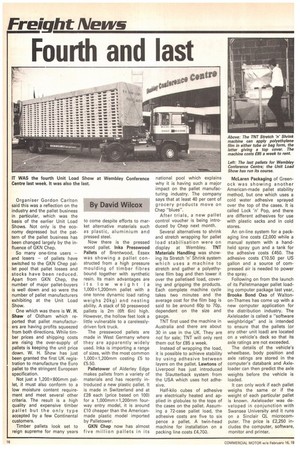Fourth and ast
Page 18

If you've noticed an error in this article please click here to report it so we can fix it.
By David Wilcox
Organiser Gordon Carlton said this was a reflection on the industry and the pallet business in particular, which was the basis of the earlier Unit Load Shows. Not only is the economy depressed but the pattern of the pallet business has been changed largely by the influence of GKN Chep.
So many one-time users — and losers — of pallets have switched to the GKN Chep pallet pool that pallet losses and stocks have been reduced. Apart from GKN Chep, the number of major pallet-buyers is well down and so were the number of pallet manufacturers exhibiting at the Unit Load Show.
One which was there is W. H. Shaw of Oldham which reported that pallet manufacturers are having profits squeezed from both directions. While timber prices and shipping costs are rising the over-supply of pallets is keeping the unit price down. W. H. Shew has just been granted the first UK registration to manufacture the Euro pallet to the stringent European specification.
Not just a 1,200x800mm pallet, it must also conform to a low moisture content requirement and meet several other criteria. The result is a high quality and expensive timber pallet but the only type accepted by a few Continental
Customers.
Timber pallets look set to reign supreme for many years to come despite efforts to market alternative materials such as plastic, aluminium and pressed steel.
Now there is the pressed wood pallet. Inka Presswood Pallets of Brentwood, Essex was showing a pallet constructed from a high pressure moulding of timber fibres bound together with synthetic resin. Its main advantages are its low weight (a 1,000x1,200mm pallet with a one tonne dynamic load rating weighs 20kg) and nesting ability. A stack of 50 presswood pallets is 2m (6ft 6in) high, However, the hollow feet look a little vulnerable to a carelesslydriven fork truck.
The presswood pallets are made in West Germany where they are apparently widely used. lnka is importing a range of sizes, with the most common 1,000x1,200mm costing £5 to £5.50.
Palletower of Alderley Edge makes pallets from a variety of materials and has recently introduced a new plastic pallet. It is made in Switzerland and at £28 each (price based on 100) for a 1,000mmx1,200mm fourway entry model, it is around £10 cheaper than the Americanmade plastic model imported by Palletower, GKN Chep now has almost five million pallets in its national pool which explains why it is having such a major impact on the pallet manufacturing industry. The company says that at least 40 per cent of grocery products move on Chep "blues", After trials, a new pallet control voucher is being introduced by Chep next month.
Several alternatives to shrink and stretch wrapping for pallet load stabilisation were on display at Wembley. TNT Materials Handling was showing its Stretch 'n' Shrink system which uses a machine to stretch and gather a polyethylene film bag and then lower it over the palletised load, covering and gripping the products. Each complete machine cycle takes two minutes and the average cost for the film bag is said to be around 60p to 70p, dependent on the size and gauge.
TNT first used the machine in Australia and there are about 30 in use in the UK. They are not for sale; TNT will only rent them out for £85 a week.
Instead of wrapping the load, it is possible to achieve stability by using adhesive between layers on the pallet. Lawtons of Liverpool has just introduced the Slautterback system from the USA which uses hot adhesive.
Half-kilo cubes of adhesive are electrically heated and applied in globules to the tops of the cases on the pallet. Assuming a 72-case pallet load, the adhesive costs are five to six pence a pallet. A twin-head machine for installation on a packing line costs £4,700. McLaren Packaging of Greenock was showing another American-made pallet stability method, but one which uses a cold water adhesive sprayed over the top of the cases. It is called Lock 'n' Pop, and there are different adhesives for use with plastic sacks and in cold stores.
An on-line system for a packaging line costs £2,000 while a manual system with a handheld spray gun and a tank for the adhesive costs £450. The adhesive costs £10.50 per US gallon and a source of compressed air is needed to power the spray.
Following on from the launch of its Palletmanager pallet loading computer package last year, Brooke Bond Oxo of Waltonon-Thames has come up with a new computer application for the distribution industry. The Axleloader is called a "software weighbridge" and is intended to ensure that the pallets (or any other unit load) are located on a vehicle's deck so that its axle ratings are not exceeded.
The details of the vehicle's wheelbase, body position and axle ratings are stored in the computer's databank and Axleloader can then predict the axle weights before the vehicle is loaded.
It can only work if each pallet weighs the same or if the weight of each particular pallet is known. Axleloader was de veloped in conjunction with Swansea University and it runs on a Sinclair QL microcomputer. The price is £2,250 includes the computer, software, monitor and printer.




























































































